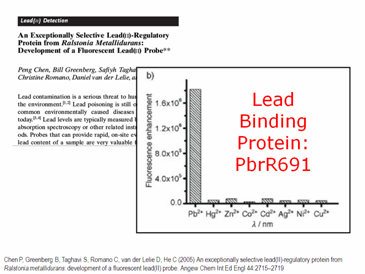\Lead Detection
From 2007.igem.org
(Difference between revisions)
| Line 104: | Line 104: | ||
<!-- PLACE CONTENT IN HERE--> | <!-- PLACE CONTENT IN HERE--> | ||
| - | [[Image:Lead Binding.png]] | + | [[Image:Lead Binding.png|thumb|right]] |
Lead contamination is a serious public health concern. However, existing lead sensors are too expensive and often require extensive lab tests. Home lead testing kits suffer from lack of accuracy – lead is often confused with other heavy metals, such as cadmium or copper. There is a need for inexpensive and selective lead detectors. | Lead contamination is a serious public health concern. However, existing lead sensors are too expensive and often require extensive lab tests. Home lead testing kits suffer from lack of accuracy – lead is often confused with other heavy metals, such as cadmium or copper. There is a need for inexpensive and selective lead detectors. | ||
We have decided to build a lead sensor in E. Coli, a cheap, simple solution to our problem. | We have decided to build a lead sensor in E. Coli, a cheap, simple solution to our problem. | ||
| + | |||
| + | |||
In our search for genes that can detect lead, we stumbled upon the gram negative bacteria Ralstonia metallidurans, which can survive in environments with high concentrations of heavy metals. This remarkable prokaryote contains a lead binding protein, PbrR691, which activates a DNA promoter, turning on transcription of a number of lead resistance genes. | In our search for genes that can detect lead, we stumbled upon the gram negative bacteria Ralstonia metallidurans, which can survive in environments with high concentrations of heavy metals. This remarkable prokaryote contains a lead binding protein, PbrR691, which activates a DNA promoter, turning on transcription of a number of lead resistance genes. | ||
| + | |||
| + | |||
This lead binding protein was shown by Chen, et al. in 2005 to be ten times more selective for lead than for several other heavy metals. Other lead binding proteins that have been identified by biologists are rarely so selective for lead. | This lead binding protein was shown by Chen, et al. in 2005 to be ten times more selective for lead than for several other heavy metals. Other lead binding proteins that have been identified by biologists are rarely so selective for lead. | ||
| + | |||
| + | |||
Not only is PbrR691 remarkably selective, the gene also has been successfully cloned into E Coli by this research group. We were confident that we could turn the lead binding protein and its corresponding lead promoter into new BioBricks for the registry. | Not only is PbrR691 remarkably selective, the gene also has been successfully cloned into E Coli by this research group. We were confident that we could turn the lead binding protein and its corresponding lead promoter into new BioBricks for the registry. | ||
| + | |||
| + | |||
(Chen P, Greenberg B, Taghavi S, Romano C, van der Lelie D, He C (2005) An exceptionally selective lead(II)-regulatory protein from Ralstonia metallidurans: development of a fluorescent lead(II) probe. Angew Chem Int Ed Engl 44:2715–2719) | (Chen P, Greenberg B, Taghavi S, Romano C, van der Lelie D, He C (2005) An exceptionally selective lead(II)-regulatory protein from Ralstonia metallidurans: development of a fluorescent lead(II) probe. Angew Chem Int Ed Engl 44:2715–2719) | ||
Revision as of 01:08, 27 October 2007

